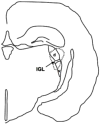Dim nighttime illumination alters photoperiodic responses of hamsters through the intergeniculate leaflet and other photic pathways
- PMID: 22155265
- PMCID: PMC3578228
- DOI: 10.1016/j.neuroscience.2011.11.037
Dim nighttime illumination alters photoperiodic responses of hamsters through the intergeniculate leaflet and other photic pathways
Abstract
In mammals, light entrains the central pacemaker within the suprachiasmatic nucleus (SCN) through both a direct neuronal projection from the retina and an indirect projection from the intergeniculate leaflet (IGL) of the thalamus. Although light comparable in intensity to moonlight is minimally effective at resetting the phase of the circadian clock, dimly lit and completely dark nights are nevertheless perceived differentially by the circadian system, even when nighttime illumination is below putative thresholds for phase resetting. Under a variety of experimental paradigms, dim nighttime illumination exerts effects that may be characterized as enhancing the plasticity of circadian entrainment. For example, relative to completely dark nights, dimly lit nights accelerate development of photoperiodic responses of Siberian hamsters transferred from summer to winter day lengths. Here we assess the neural pathways underlying this response by testing whether IGL lesions eliminate the effects of dim nighttime illumination under short day lengths. Consistent with previous work, dimly lit nights facilitated the expansion of activity duration under short day lengths. Ablation of the IGL, moreover, did not influence photoperiodic responses in animals held under completely dark nights. However, among animals that were provided dimly lit nights, IGL lesions prevented the short-day typical expansion of activity duration as well as the seasonally appropriate gonadal regression and reduction in body weight. Thus, the present data indicate that the IGL plays a central role in mediating the facilitative effects of dim nighttime illumination under short day lengths, but in the absence of the IGL, dim light at night influences photoperiodic responses through residual photic pathways.
Copyright © 2011 IBRO. Published by Elsevier Ltd. All rights reserved.
Figures




Similar articles
-
Circadian effects of light no brighter than moonlight.J Biol Rhythms. 2007 Aug;22(4):356-67. doi: 10.1177/0748730407301988. J Biol Rhythms. 2007. PMID: 17660452
-
The thalamic intergeniculate leaflet modulates photoperiod responsiveness in Siberian hamsters.Brain Res. 2004 Nov 26;1028(1):31-8. doi: 10.1016/j.brainres.2004.08.049. Brain Res. 2004. PMID: 15518639
-
Circadian entrainment and phase resetting differ markedly under dimly illuminated versus completely dark nights.Behav Brain Res. 2005 Jul 1;162(1):116-26. doi: 10.1016/j.bbr.2005.03.014. Epub 2005 Apr 9. Behav Brain Res. 2005. PMID: 15922072
-
The circadian visual system.Brain Res Brain Res Rev. 1994 Jan;19(1):102-27. doi: 10.1016/0165-0173(94)90005-1. Brain Res Brain Res Rev. 1994. PMID: 7909471 Review.
-
Light sensitivity of the photoperiodic response system in higher vertebrates: wavelength and intensity effects.Indian J Exp Biol. 1999 Nov;37(11):1053-64. Indian J Exp Biol. 1999. PMID: 10783735 Review.
Cited by
-
Naturalistic Intensities of Light at Night: A Review of the Potent Effects of Very Dim Light on Circadian Responses and Considerations for Translational Research.Front Neurol. 2021 Feb 1;12:625334. doi: 10.3389/fneur.2021.625334. eCollection 2021. Front Neurol. 2021. PMID: 33597916 Free PMC article. Review.
-
Extraordinary behavioral entrainment following circadian rhythm bifurcation in mice.Sci Rep. 2016 Dec 8;6:38479. doi: 10.1038/srep38479. Sci Rep. 2016. PMID: 27929128 Free PMC article.
-
Geniculohypothalamic GABAergic projections gate suprachiasmatic nucleus responses to retinal input.J Physiol. 2017 Jun 1;595(11):3621-3649. doi: 10.1113/JP273850. Epub 2017 Apr 11. J Physiol. 2017. PMID: 28217893 Free PMC article.
-
Mapping behaviorally relevant light pollution levels to improve urban habitat planning.Sci Rep. 2019 Aug 15;9(1):11925. doi: 10.1038/s41598-019-48118-z. Sci Rep. 2019. PMID: 31417105 Free PMC article.
-
Using light to tell the time of day: sensory coding in the mammalian circadian visual network.J Exp Biol. 2016 Jun 15;219(Pt 12):1779-92. doi: 10.1242/jeb.132167. J Exp Biol. 2016. PMID: 27307539 Free PMC article. Review.
References
-
- Aschoff J. Exogenous and endogenous components in circadian rhythms. Cold Spring Harb Symp Quant Biol. 1960;25:11–28. - PubMed
-
- Aschoff J. Circadian rhythms: Influences of internal and external factors on the period measured in constant conditions. Z Tierpsychol. 1979;49:225–249. - PubMed
-
- Belenky MA, Smeraski CA, Provencio I, Sollars PJ, Pickard GE. Melanopsin retinal ganglion cells receive bipolar and amacrine cell synapses. J Comp Neurol. 2003;460:380–393. - PubMed
-
- Berson DM. Strange vision: Ganglion cells as circadian photoreceptors. Trends Neurosci. 2003;26:314–320. - PubMed
-
- Biberman LM, Dunkelman L, Fickett ML, Finke RG. Levels of Nocturnal Illumination. Washington, D.C: Institute for Defense Analyses, Research, and Engineering Support Division; 1966.
Publication types
MeSH terms
Grants and funding
LinkOut - more resources
Full Text Sources

